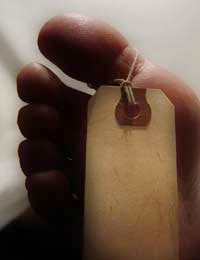Epilogue - The truth told.
Behold, my fellow readers! After weeks of continuous investigation and analysis, we now have the truth of this murder case in our hands. So, let us bring to you the very last piece of story to complete the whole puzzle! :)

Frustration filled up the investigation room as the doctors couldn't figure out the culprit for the murder case. At the verge of giving up, Dr Rudi angrily swept the table with her arm, scattering the documents around. The DNA report of the victim laying on the floor then caught Dr. Suriati's eye and she picked it up. "Why didn't you check through the other traces of DNA?" she asked. "Its irrelevant to our case Suri... Plus ,the amount is too little to be considered as evidence." "No! Look at chromosome 22 here, they are similar!" exclaimed Dr Suri.
Frustration filled up the investigation room as the doctors couldn't figure out the culprit for the murder case. At the verge of giving up, Dr Rudi angrily swept the table with her arm, scattering the documents around. The DNA report of the victim laying on the floor then caught Dr. Suriati's eye and she picked it up. "Why didn't you check through the other traces of DNA?" she asked. "Its irrelevant to our case Suri... Plus ,the amount is too little to be considered as evidence." "No! Look at chromosome 22 here, they are similar!" exclaimed Dr Suri.
Through further investigation, it is found that the DNA belongs to Anya's father......
"What were you doing on 28th October 2014 from 6.30 pm till 9.00 pm?" asked Detective Tham.
"I was in the park, playing with my daughter, like I reported," answered Ray swiftly. "We've found traces of your DNA among the evidence in your daughter, Anya's crime case. How do you explain this?!"
Cold sweat ran through Ray's face, his body was trembling. "I..I..I.." he stuttered. " Its because you killed your own daughter!" exclaimed Detective Tham. Ray broke down in tears, finally admitting to the murder.
"It's all his fault! I wouldn't have killed my sweet sweet Anya if he hadn't showed up and snatched my wife away!" Ray cried harder. "We were a happy family until he showed up, I no longer see the spark in my wife's eyes". "I loved her so much, I saw that bastard playing with his son happily at that park that day. They don't deserve this kind of happiness after what they did to my family!" he said as hatred filled his eyes. "I don't get it, why kill your own daughter?" Detective asked. "I didn't mean to! It was an accident! She tried to stop me, but I was blinded by my emotions. I wanted to hit that bastard but Anya got in the way. As she bled, I got angrier and killed both that rascal and his son." Ray said as he burst out in tears.
As we have now reached the epilogue, we would like to thank everyone who has been following us through this enthralling journey ;) Hope you have learned something new and perhaps feeling inspired to be the next Sherlock Holmes? ;) Also, a big thanks to the lecturer for giving us this opportunity to gain new knowledge and to work together as a team! :)

The End. :)
"I was in the park, playing with my daughter, like I reported," answered Ray swiftly. "We've found traces of your DNA among the evidence in your daughter, Anya's crime case. How do you explain this?!"
Cold sweat ran through Ray's face, his body was trembling. "I..I..I.." he stuttered. " Its because you killed your own daughter!" exclaimed Detective Tham. Ray broke down in tears, finally admitting to the murder.
"It's all his fault! I wouldn't have killed my sweet sweet Anya if he hadn't showed up and snatched my wife away!" Ray cried harder. "We were a happy family until he showed up, I no longer see the spark in my wife's eyes". "I loved her so much, I saw that bastard playing with his son happily at that park that day. They don't deserve this kind of happiness after what they did to my family!" he said as hatred filled his eyes. "I don't get it, why kill your own daughter?" Detective asked. "I didn't mean to! It was an accident! She tried to stop me, but I was blinded by my emotions. I wanted to hit that bastard but Anya got in the way. As she bled, I got angrier and killed both that rascal and his son." Ray said as he burst out in tears.
As we have now reached the epilogue, we would like to thank everyone who has been following us through this enthralling journey ;) Hope you have learned something new and perhaps feeling inspired to be the next Sherlock Holmes? ;) Also, a big thanks to the lecturer for giving us this opportunity to gain new knowledge and to work together as a team! :)
The End. :)





























